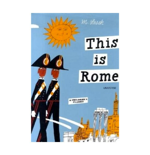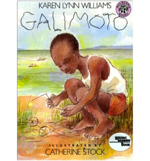By Holly Johnson, University of Cincinnati, Cincinnati, OH
Like most people, when I read I have images playing my head, almost like a movie. I am traveling! But to get that movie and to take that journey, I need some prior knowledge about the setting of the story along with other details that bring the text to life. If I have a sense of the setting I don’t attend to the description as much as when I need to build the picture in my head from scratch. If I have been to a place, it serves as a handy backdrop to the piece of literature I am reading. When I haven’t been there, I need help. Of course, most of us do not have the extensive travel experience we would need (or like) to feel comfortable reading in this way. But travel is handy. It was also my passion when I was younger, and so I find that my experience of different places I have been are useful for my reading of international literature—on two accounts.
 First, I like reading about where I have been. The reading is enriched when I can picture it. I pull the images from my memory to help envision the world to which the author has led me. Secondly, the reading enriches my experience of the places I have traveled. It’s also great to find books to read about a place—whether fiction or informational—when planning to travel in it. Some fun texts for cities across the globe are the Miroslav Sasek series such as This is London and This is Rome. These books were written in the 1960s and 1970s, but have “this is today” excerpts that help students see how cities change over time.
First, I like reading about where I have been. The reading is enriched when I can picture it. I pull the images from my memory to help envision the world to which the author has led me. Secondly, the reading enriches my experience of the places I have traveled. It’s also great to find books to read about a place—whether fiction or informational—when planning to travel in it. Some fun texts for cities across the globe are the Miroslav Sasek series such as This is London and This is Rome. These books were written in the 1960s and 1970s, but have “this is today” excerpts that help students see how cities change over time.
This is Rome, first published in 1960, traces the history of Roman civilization to bring to life the Rome of the 60’s. Sasek navigates Rome’s busy, winding streets to visit such glorious historical landmarks as the statues of Michelangelo, Vatican City, the Pantheon, and the Fontana di Trevi–and to show us the eccentricities of modern Roman life, from its colorful trains, trams, and taxis to its chic espresso bars and pasta houses.
Books like Elizabeti’s School (Stuve-Bodeen, 2002) and Galimoto (Williams, 1991) give readers a sense of rural southern Africa, while informational texts such as A Long Way Gone: Memoirs of a Boy Soldier (Beah, 2007), Facing the Lion: Growing Up Maasai on the African Savanna (National Geographic) (Lemasolai-Lekuton, 2005), and The Sudan Project: Rebuilding With the People of Darfur – A Young Person’s Guide (Leembruggen, 2007) might be suitable for older students interested in memoirs from African writers. Other texts would include Secrets of the Savanna: Twenty-three Years in the African Wilderness Unraveling the Mysteries of Elephants and People (Owens & Owens, 2007) and Whatever You Do, Don’t Run: True Tales of a Botswana Safari Guide (Allison, 2007). I just bought the Botswana book because of my own connection to that country.

This book is set in the small Southern African country of Malawi, the country in which I spent the first 19 years of my life. This book is very dear to me because of its connection to my home. However, it is a good book in its own right. I can say that the language used in the book is authentic (galimoto is, in fact, Chichewa for car). The illustrations are also accurate. Although the book is intended for smaller children, I think that it is a helpful book for older kids as well. I have read this story to my 7th graders, and it has prompted many discussions on other cultures.
–Malinda Upton (amazon.com)
Using a variety of texts builds our understandings of a place and its people. I would think it would also build our understandings of ourselves as we reflect upon how we respond to a place, its people, its images, and its words. But given that we can’t always travel, how can we “travel” using international literature? How can we build student interest in a place through texts so they begin to dream of the travel they might be able to take one day? What ways can we create curricular engagements for students to help them travel in place while waiting for the time they can do it on their own?
Journey through Worlds of Words during our open reading hours: Monday-Friday, 9 a.m. to 5 p.m. and Saturday, 9 a.m. to 1 p.m. To view our complete offerings of WOW Currents, please visit archival stream.
- Themes: Holly Johnson
- Descriptors: Books & Resources, Debates & Trends, WOW Currents
